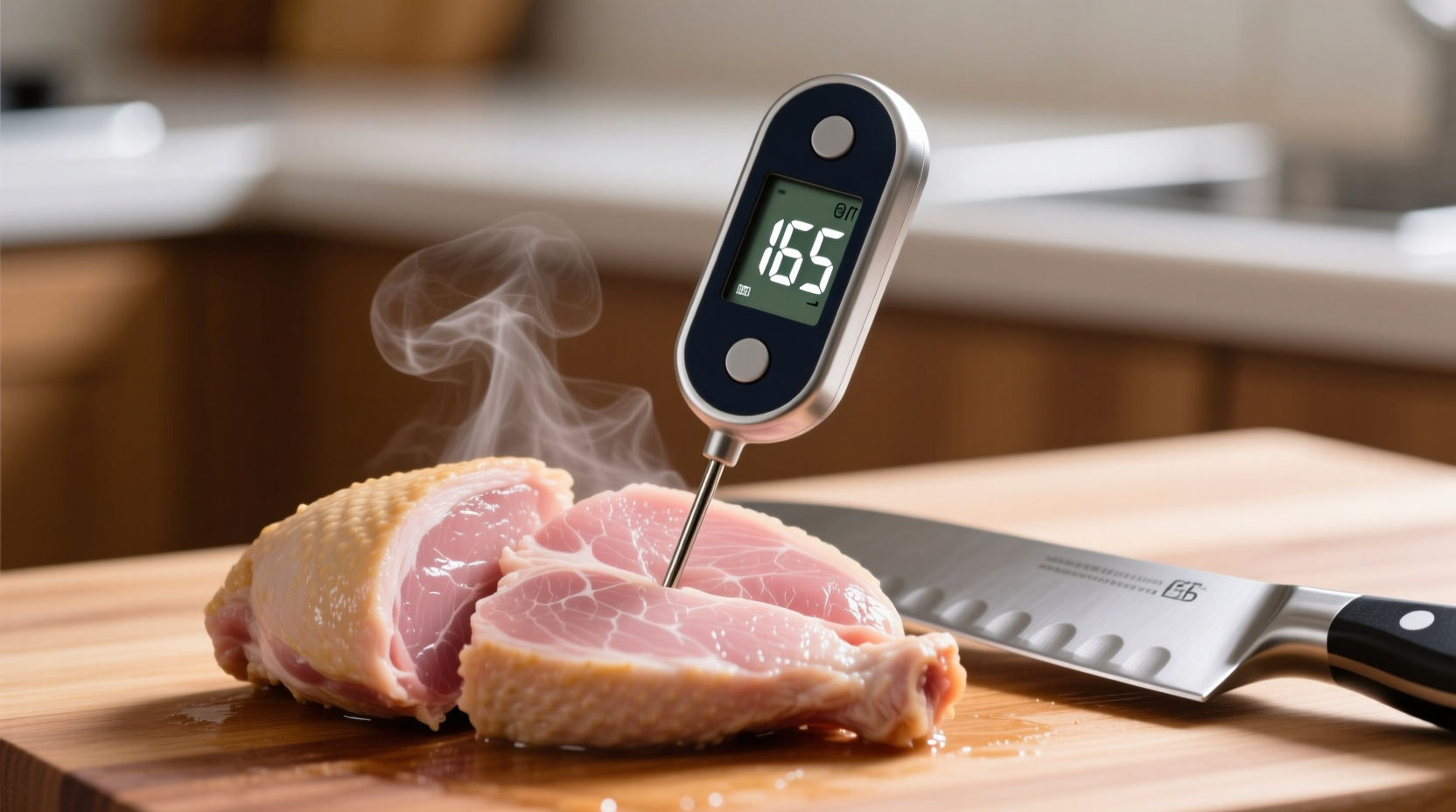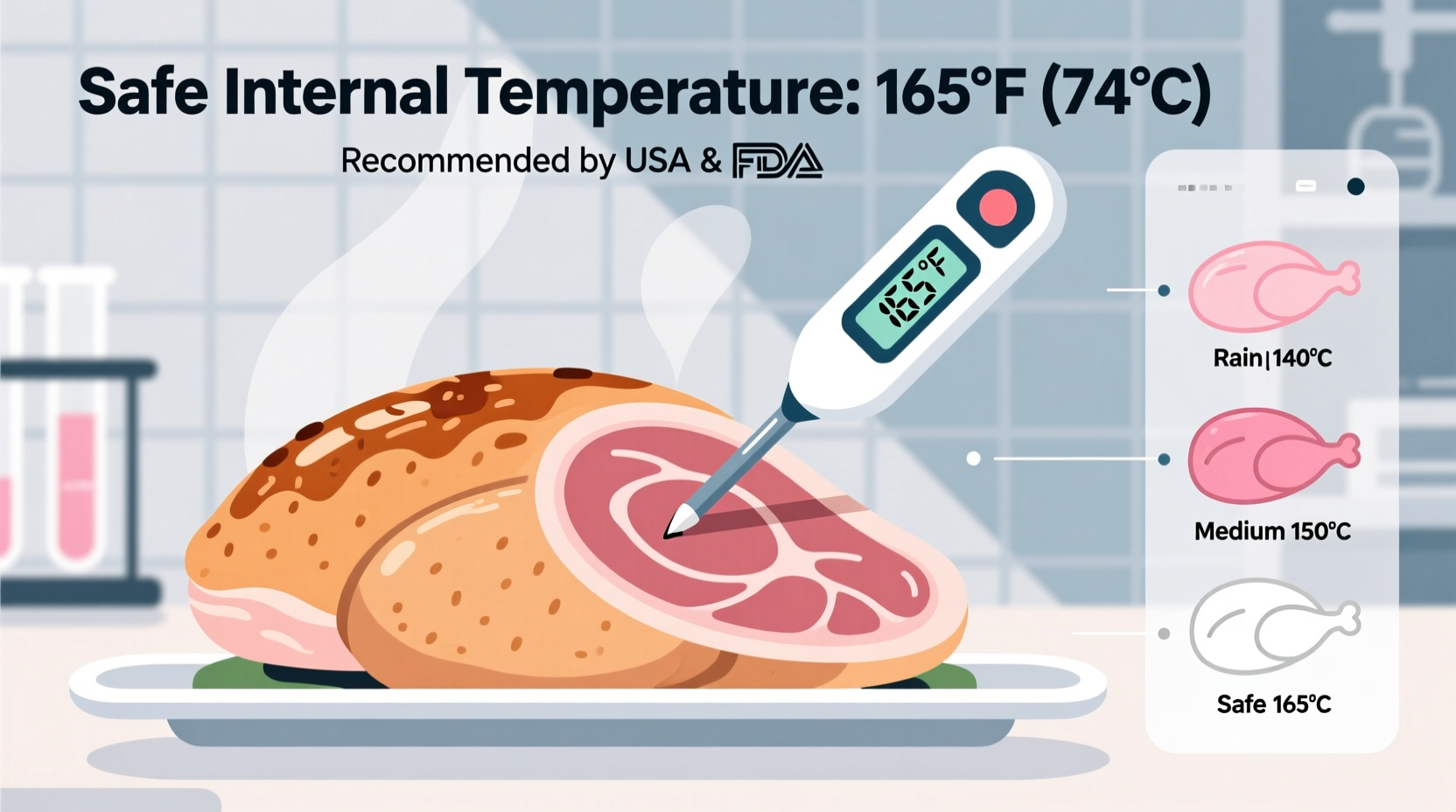Discover exactly what temperature chicken should be cooked to for perfect food safety without sacrificing quality. In this comprehensive guide, you'll learn not just the recommended temperature, but how to measure it correctly, why it matters for your health, and practical tips for achieving perfectly cooked chicken every time. Whether you're a beginner cook or experienced chef, these evidence-based guidelines will keep your kitchen safe and your meals delicious.
Why Chicken Temperature Matters: The Food Safety Imperative
Chicken requires specific temperature guidelines because it commonly carries pathogens like Salmonella and campylobacter that can cause serious foodborne illness. According to the CDC, these bacteria cause millions of illnesses annually in the United States alone. The USDA's Food Safety and Inspection Service confirms that poultry must reach 165°F to eliminate these dangerous microorganisms.
Unlike beef or pork, chicken's structure allows bacteria to penetrate deeper into the meat, making surface cooking insufficient. This is why visual cues like color changes aren't reliable indicators of safety. Only a properly calibrated food thermometer can verify that chicken has reached the necessary internal temperature to destroy harmful bacteria.
The Science Behind the 165°F Standard
The 165°F recommendation isn't arbitrary—it's based on rigorous scientific research. At this temperature, harmful bacteria are destroyed almost instantly. The USDA's research shows that Salmonella is eliminated within seconds at 165°F, providing a critical safety margin.
| Temperature | Time to Destroy Salmonella | Practical Implication |
|---|---|---|
| 165°F (74°C) | Nearly instantaneous | USDA recommended safe temperature |
| 160°F (71°C) | 14 seconds | Acceptable with precise timing |
| 150°F (66°C) | 2.8 minutes | Riskier, requires careful monitoring |
| 140°F (60°C) | 35.5 minutes | Not recommended for home cooking |
This temperature-time relationship explains why professional chefs sometimes use lower temperatures with precise timing, but for home cooks, 165°F remains the safest and most practical standard. The FDA Food Code specifically states: "Poultry (chicken, turkey, duck) must be cooked to 165°F as measured with a food thermometer." (FDA Food Code 2022, Section 3-401.11)

How to Measure Chicken Temperature Correctly
Knowing what temperature chicken should be cooked to is only half the battle—you must measure it properly:
- Use the right thermometer: Digital instant-read thermometers provide the most accurate results for home cooks
- Insert in the thickest part: Avoid bones, fat, or gristle which can give false readings
- Check multiple spots: Especially for larger pieces like whole chickens or stuffed breasts
- Wait for stabilization: Keep the thermometer in place until the reading stops changing
- Clean between uses: Prevent cross-contamination by sanitizing your thermometer
Common mistakes include checking too early in the cooking process, inserting the thermometer near bone (which conducts heat differently), or not checking multiple locations in larger cuts. Remember that chicken continues to cook during resting time, so remove it from heat when it reaches about 160°F to allow for carryover cooking to 165°F.
Temperature Guidelines for Different Chicken Cuts
While the 165°F standard applies universally to all chicken products, different cuts require attention to specific details:
- Whole chicken: Check temperature in the innermost part of the thigh and wing, and the thickest part of the breast
- Chicken breasts: Measure in the thickest portion, avoiding the bone if present
- Thighs and drumsticks: Insert thermometer into the meaty part of the thigh, not touching bone
- Ground chicken: Requires special attention as bacteria can be distributed throughout
- Stuffed chicken: Both the chicken and the stuffing must reach 165°F
For sous vide cooking enthusiasts, the FDA allows lower temperatures with extended cooking times (145°F for 26.5 minutes), but this requires precise temperature control that most home kitchens can't guarantee. For conventional cooking methods, 165°F remains the gold standard for chicken doneness temperature.
What Happens If You Cook Chicken Below 165°F?
While some chefs advocate for lower temperatures with precise timing, the USDA maintains 165°F as the safe minimum for good reason. The Food Safety and Inspection Service explains that lower temperatures require exact timing that's difficult to achieve consistently in home kitchens.
Undercooked chicken may appear done (white throughout with clear juices) while still harboring dangerous bacteria. The CDC reports that Salmonella can survive at temperatures as high as 150°F if not maintained for sufficient time. This is why visual indicators alone aren't reliable for determining chicken safety.
Resting Time: The Final Safety Step
After reaching 165°F, allow chicken to rest for 3-5 minutes before cutting. During this time:
- Temperature remains above lethal levels for any remaining bacteria
- Juices redistribute throughout the meat
- Carryover cooking may increase temperature slightly
- Texture improves significantly
This resting period provides an additional safety margin while improving eating quality. Never skip this step when cooking chicken to proper temperature.
Common Misconceptions About Chicken Cooking Temperature
Several myths persist about determining when chicken is done:
- "Clear juices mean it's done" - While juices should be clear, this isn't a reliable indicator of safety
- "White color indicates doneness" - Chicken can appear white before reaching safe temperatures
- "Boneless chicken cooks faster" - Boneless may cook slightly faster, but still requires 165°F
- "Organic chicken is safer" - All chicken requires the same temperature guidelines
The only reliable method to determine if chicken has reached the proper cooking temperature is with a calibrated food thermometer. Don't rely on timers, color, or texture alone when asking what temperature chicken should be cooked to.
International Temperature Standards Comparison
While the USDA standard is 165°F, other countries have slightly different guidelines based on their food safety research:
| Country/Region | Recommended Temperature | Notes |
|---|---|---|
| United States (USDA) | 165°F (74°C) | Universal standard for all poultry |
| Canada (CFIA) | 165°F (74°C) | Same as USDA standard |
| United Kingdom (FSA) | 75°C (167°F) | Measured in thickest part, 30 seconds |
| Australia (FSANZ) | 74°C (165°F) | With 15-second hold time |
| European Union | 72-74°C (162-165°F) | Varies by member state |
Despite minor variations, all major food safety authorities agree that poultry must reach temperatures that eliminate harmful bacteria. The slight differences reflect varying approaches to safety margins rather than conflicting science.
Essential Tools for Perfect Chicken Every Time
Investing in the right equipment makes achieving the proper chicken cooking temperature much easier:
- Digital instant-read thermometer: Provides accurate readings in 3-5 seconds
- Leave-in probe thermometer: Monitors temperature continuously during cooking
- Calibration tools: Ice water (32°F/0°C) and boiling water (212°F/100°C) tests
- Resting rack: Allows air circulation during resting period
Regularly calibrate your thermometer to ensure accuracy—even a 5-degree error could mean the difference between safe and unsafe chicken. The USDA recommends checking thermometer accuracy monthly for frequent users.











 浙公网安备
33010002000092号
浙公网安备
33010002000092号 浙B2-20120091-4
浙B2-20120091-4